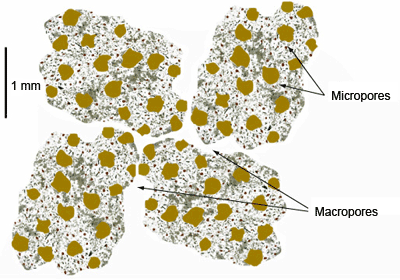Porosity
Soil Colour | Soil Particles | Bonding and Aggregation | Porosity | Changing Soil Structure | Soil Strength
Porosity is the pore space in soil between mineral particles (and solid organic matter) filled with either air or water. The pore space both contains and controls most of the functions of soil. It is not just the total amount of pore space that is important, but the size distribution of the pores, and the continuity between them which determines function and behaviour of soil.
Size Distribution of Pores
Pores range in diameter from a few millimetres right down to just a fraction of a micron (i.e. one thousandth of a millimeter). The following table gives some detail of this range.
Pore Sizes in Soil (Rowell 1994)
| Pore diameter (µm) | Nature of the pore |
20000 | A 20 mm crack |
| 4000 | An earthworm channel (4 mm) |
| 300 | The diameter of a grass root |
| 60-30 | The smallest pore that will be air filled at field capacity |
| 10 | A fungal hypha |
| 2 | The size of a bacterial cell. The largest clay particle. The smallest pore from which a plant can readily obtain water |
| 0.2 | The smallest pore that will give up water to the suction exerted by a plant root. The pore size corresponding to the permanent wilting point |
| 0.003 | The largest pore filled with water in an "air dry" soil. The pore size is approximately ten times the diameter of a water molecule |
This table indicates that different pores act in quite different ways. It is convenient to group them in terms of behaviour.
Transmission Pores
Transmission pores are the large pores which enable root growth, air movement and water movement. They are visible to the naked eye, indeed even with a x5 hand lens, and range between 30 to 60 µm. They are often called macropores. The volume of a soil occupied by transmission pores should be >10 % if plant roots are to get adequate oxygen. Coarse textured, sandy soils, and well structured soils with a lot of biological activity, have a large proportion of pores in this size class.
Storage Pores
Storage pores retain water (ie. they do not drain under the force of gravity) which is then available for use by plant roots and soil organisms. The proportion of these pores in a soil controls the plant available water capacity. They (along with even smaller pores) are termed micropores. They have diameters between 0.2 and 60 µm. The volume of a soil occupied by them might range from <10% in a loamy sand to >20% in a good loam.
Residual Pores
These hold water so tightly that it cannot be extracted by roots or soil organisms – they are less than 0.2 µm in diameter. Fine textured or clayey soils have the larger proportion of their pores in this class. A heavy clay might well have 25 % of its volume as residual pores.
In visual terms macropores and micropores can be represented as follows:



